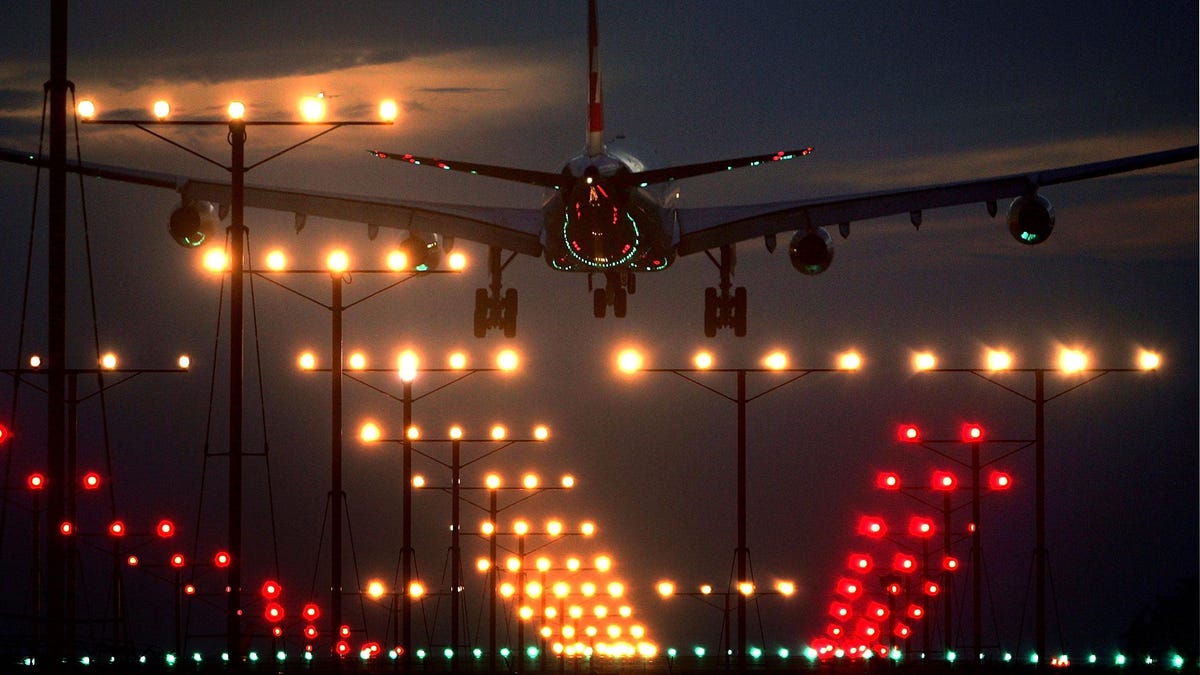Detroit Airport's Runway Approach Lights Keep Shutting Off When They're Needed Most

For illustration purposes, a photo of the Approach Lighting System at Los Angeles International Airport. The ALS consists of an array of lights mounted on poles high above the ground, marking a path toward the beginning of the runway.Photo: David McNew / Staff (Getty Images)
Air traffic controllers at Detroit Metro Airport say the airport’s approach lighting system (ALS) is falling apart. The lights, mounted high above the ground and stretching up to hundreds of yards ahead of the start of a runway, are meant to give pilots a visual guide when landing at night or during inclement weather. But according to whistleblowers at the airport, the lights are dim and unreliable, and when controllers attempt to turn them up to full brightness during bad weather, the system goes into a failure mode.
Detroit’s ABC 7 News first reported the problems with DTW’s approach lighting system, as part of a broader investigation into unsafe landing practices at the airport. While investigating a problem with a faulty system that sometimes forces pilots to abort their landing attempts, ABC 7 listened to recordings of Air Traffic Control communications with pilots, and found numerous instances of pilots reporting major problems with the ALS.
When it’s functioning correctly, the ALS is meant to help pilots transition from instrument flight to visual flight, giving a brightly visible guide for pilots to line up the plane with the runway and establish a proper glidepath. An airport’s ALS can pierce through fog and clouds to be the first indication of the runway that a pilot sees. In the image below, the ALS is the array of red and white lights in front of the green lights that indicate the runway’s threshold.
For illustration purposes, a photo depicting ALS lights at an unspecified airport. These lights can extend as far as 3000 feet from the end of the runway.Photo: Solutions 4 GA
Air traffic controllers at Detroit’s airport report that when they turn the ALS lights up to their brightest settings, the system goes into a caution or failure mode. Entire sections of the lights may go dark.
“They won’t stay in the highest levels, and we need the highest levels when it’s the worst weather,” the whistleblower, who works in air traffic control at DTW, told ABC 7. (The station is not identifying the whistleblower by name.) “[T]hey’re constantly going into fault—and you’re not able to run them at the correct levels because of this.”
Air traffic controllers at DTW are forced to ask approaching pilots to confirm whether the ALS is even working. ABC 7 transcribes some of these conversations, including this one, which took place as a plane was about to land during a snowstorm on February 3rd of this year:
Tower: “Just got a failure indication for 4 Left approach lights, if you can let me know if they’re still on or not… We had this issue yesterday and they were still on, so let’s cross our fingers on that one.”
Pilot: “Tower, Delta 2767 – we got the approach lighting…”
[…]
Another pilot: “On the center line white there are about five burned out. On the red from the side, there were 2 full red trees out, then another 2 burned out lights, so maybe 15 burned out. That may be why you’re getting error.”
Here’s where things get complicated: In the U.S., an airport’s ALS lights are maintained by the Federal Aviation Administration, not the airport itself. (The lights that mark the edges of the runway are the airport’s responsibility.) Every year, the FAA inspects the lighting at Detroit’s airport. Last year, that inspection took four hours longer than expected, the whistleblower told ABC 7: “While they were out doing their inspection, numerous runways and approach lighting systems failed […] Every runway they inspected, the electricians were following right behind them to go over and try to fix the stuff they were pointing out. And it was one runway after another.”
During the FAA inspection, numerous malfunctioning lights were identified, which were allegedly fixed. In a statement, the FAA told ABC 7, “All lighted systems at DTW are currently operating safely. Experts inspect the system weekly, and the FAA and airport monitor the performance at all times. If a light is out, the FAA makes repairs, tests it and returns it to service. Multiple systems on the runway and in the aircraft allow pilots to land safely.” But air traffic controllers at DTW say the system is still malfunctioning.
Thankfully, pilots are trained on how to handle situations like this. If pilots can’t see the ALS or runway environment, they will abort the landing, go around and try again. If a safe landing still isn’t possible, a flight can divert to another airport. At best, that’s an inconvenience. At worst, DTW’s malfunctioning approach lighting system makes a pilot’s job harder during a critical stage of flight.




